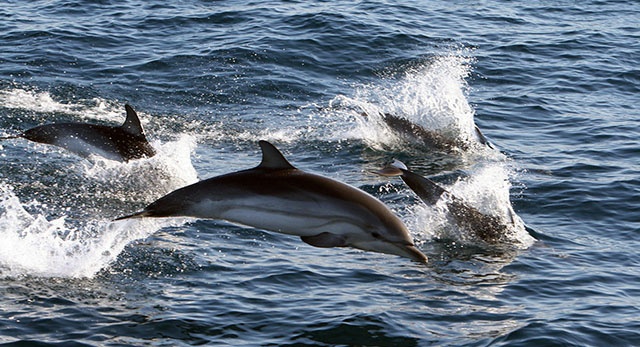In an article published in the scientific magazine ‘MEPS’, a research team of the Cavanilles Institute of Biodiversity and Evolutionary Biology at the Scientific Park of the Universitat de València, shows the ability of the striped dolphin to benefit from trophic cascade effects caused by overfishing. This situation has produced a change in the diet of the cetacean that allows it to preserve its energetic balance.
The study is based on the stomach content analysis of 140 striped dolphins (Stenella coeruleoalba) stranded in the Spanish Mediterranean coast during the period 1990-2012. The scientists found during all the process remains of oceanic (deep-sea) and neritic (nearer to the coast) preys. However, in the last mentioned decade, they observed an important decrease of oceanic samples and a significant increase of two neritic preys: the juvenile hake ‘Merluccius merluccius’ (small hake) and the squid ‘Illex coindetii’ (southern shortfin squid).
What is the reason for this change in the diet of the cetacean? How does this affect its energetic balance? Even though it is true that striped dolphins’ main habitat is open sea, in waters 900 to 1900 m in depth, researchers link the change in the diet with predatory incursions into coastal waters, since the 2000 year. According to the study, this habitat shift was most likely related to an increase of some neritic prey, especially juvenile hake, which was linked to the decline of demersal top predators such as monkfish and adult hake. According to the predictions of the trophodynamic models, which analyse all the trophic relationships chain of the marine ecosystem, these species have been affected by overfishing. ‘The striped dolphins, even if they are oceanic, sporadically perform incursions in shallower waters, show a great flexibility in their diet and are able of adapting to the new available trophic resources caused by the indirect effects of overfishing’, affirms Francisco Javier Aznar, one of the authors of the work. ‘Once the great amount of juvenile hake and squids near to the coast was detected, dolphins would have discovered that feeding on this preys, which are highly accessible, abundant and available for them, is easy and worthwhile’, he says.
Cetaceans are aquatic mammals that have high feeding needs because of their high metabolism. Therefore, the question is whether the change in the diet that is apparently linked to overfishing could have impact on the population, as previous studies suggested. The data about stomach content do not support this hypothesis, since the energetic value of the new preys is not lower to the fishes and oceanic cephalopod that were the previous feeding to dolphins. In fact, the demographic data confirm this idea. ‘It seems pretty clear that the trophic adaptability has been even beneficial for this cetacean’ says Juan Antonio Raga, co-author of the study. ‘Despite of having suffered two viral massive death tolls between 1990 and 2007, we have evidence that the population of striped dolphin has recovered from it and it has one of the highest densities of all Mediterranean’.
The paper, which is now coming out, includes the analysis of a time period of more than two decades. This analysis is currently conducted by the research team with the data obtained in the last five years. The long-term studies about trophic ecology are fairly unusual, especially in the case of marine mammals. However, these are crucial to obtain information about many ecological procedures, including those linked to the effects of the climate change, for instance. In this regard, the project has the logistical and economic support of the ‘Servicio de Vida Silvestre’ of the Valencian Government for the creation and maintenance of the cetacean stranding networks, as well as specific projects of MINECO and the Valencian Government (Prometeo).


